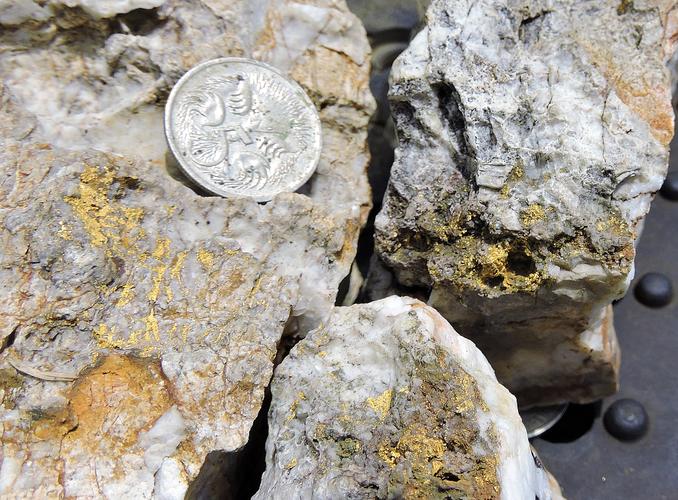
Types of gold ores existing in nature:
In nature, gold ore can exist in sand or alluvial raw materials. This kind of gold ore is called placer gold or alluvial gold ore. The raw materials are stone, sand, gravel, soil, sticky clay, and sometimes contain minerals such as magnetic iron. The mining sites of gold mines may be near rivers, on land, in mountains, in bushes, etc. Gold concentrates are visible to the naked eye, usually in the size of large gold nuggets +2mm, or gold sand -1mm.
Another type of gold ore is hard rock gold ore, where gold exists in hard rocks, such as ordinary stones, quartz veins above the land, or rock gold underground. Rock gold ore may be oxide ore and sulfide ore. These two different types of gold ore have different processing methods.
How to find the mine location of gold ore?
The easiest way to find gold on land or underground is to use a gold detector, a machine that is manually operated and popular with small gold miners who try to find gold or other metals underground, then try to dig out the gold ore, and then separate the gold with a small sluice and washing machine.
For large-scale gold mining, other large gold mine detection machines are used to determine the exact location of the gold mine and blast out the rock gold stone. Then send it to the next processing plant.
Gold ore distribution in the world:
Africa, South America Mali, Sudan, Mozambique, Suriname, Ghana, Congo, Zimbabwe, Zambia, Tanzania, Ethiopia, Peru, Chile, Bolivia, Australia, the United States and other countries are very rich in gold mines.
The conditions of gold mines vary greatly in different counties and regions, so the gold processing plants are also different.
The development of gold processing plants
Traditional alluvial gold and placer gold concentrators use gold pans and gold washing troughs, which are mostly used by small miners. The old method of rock gold concentrators is to crush and grind the gold ore into small pieces and mix it with mercury, and then use a distiller to extract gold from the mixed gold mercury ore.
But now, the government has banned the use of mercury because it is harmful to health and the environment. Therefore, miners must find a more environmentally friendly method for gold processing plants.
Jiangxi Mingxin Metallurgical Equipment Co., Ltd. has more than 30 years of professional experience in gold processing plants, designs a full set of gold mining process flow charts, provides a full set of gold processing plants, and can send engineers to the mine for equipment installation and commissioning guidance. Many gold processing plants have been built in African countries. Including: Mali, Sudan, Mozambique, Suriname, Ghana, Congo, Zimbabwe, Zambia, Tanzania, Ethiopia, Peru, Chile, Bolivia, Australia, etc.
The following is a flowchart recommended by engineers for alluvial and rock gold ore processing plants:
Alluvial gold processing plant:
Feeding->Washing->Screening->Preliminary separation->Final concentration->Refining
Feeding: There are many ways to feed, depending on the plant and the material conditions. Vibrating feeders, feed hoppers, belt feeders, wheel loaders or excavators can be used for direct feeding. Generally, a grid will be made on the vibrating feeder or hopper to remove larger waste rocks.
Washing: Used to wash clay and mud in raw materials. The most commonly used ones are gold washing drum washers and gold rotary screens.
Drum mud washers are used to wash raw materials with more clay, and drum screens are used to wash raw materials without too much clay.
Screening: After washing, some larger waste rocks are screened out, and the slurry under the screen will enter the next separator. This screening process can use a rotary screen or a vibrating screen or a high-frequency vibrating screen.
Primary beneficiation: For the primary beneficiation process of gold, it is best to use a gold centrifugal concentrator and a jig, and the concentrate from them is sent to the final concentrator.
Final concentration: The concentrate from the gold jig or gold centrifugal concentrator will enter the gold shaker concentrator for final concentration, and high-purity gold can be obtained.
Tailings recovery: The tailings discharged from the gold centrifuge are usually recovered with a gold chute. This can get more gold.
Refining: If you need very high purity gold and need to smelt it into gold bars for sale, you can use a gold induction smelting furnace to smelt the gold powder into gold bars. Then it can be sold.
The most efficient gold ore processing plant is always based on the miner's requirements and gold ore conditions and the capabilities of the gold ore processing plant.
The flow chart of the rock-type gold ore processing plant is as follows:
Feeding -> Crushing -> Grinding -> Primary separation -> Final concentration -> Quality improvement
The feeding method, primary selection, final concentration and gold refining process are basically the same as the above-mentioned placer gold processing plant.
Following is the description of Crushing and Grinding stages of Rock Gold Ore Processing Plant:
Crushing: It is used to break the large pieces of gold ore into smaller sizes before grinding.
Crusher can be coarse rock gold ore jaw crusher, rock gold ore fine crushing jaw crusher, rock gold ore cone crusher, rock gold ore hammer crusher, roller crusher rock gold ore, it depends on the feed size of rock gold ore and processing capacity to use which crusher.
Grinding: After crushing the gold ore into smaller size, it needs to be ground by gold ore ball mill or wet disc mill or other gold ore grinding machine so that the gold concentrate can be released from the ore. Then it goes into gold separator and concentrator. (Gold Ore Shaker)
